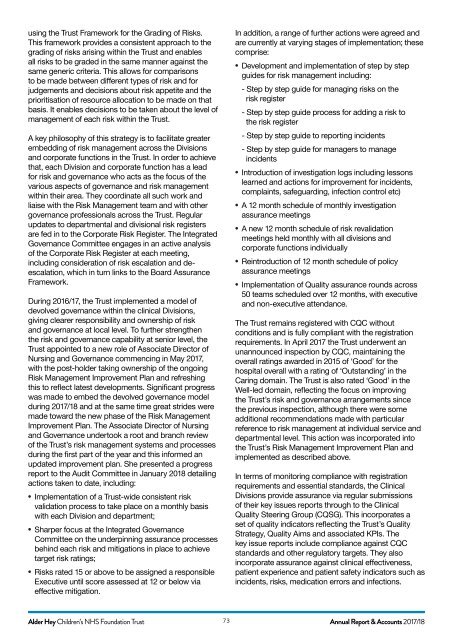AH ANNUAL REPORT 2018
Create successful ePaper yourself
Turn your PDF publications into a flip-book with our unique Google optimized e-Paper software.
using the Trust Framework for the Grading of Risks.<br />
This framework provides a consistent approach to the<br />
grading of risks arising within the Trust and enables<br />
all risks to be graded in the same manner against the<br />
same generic criteria. This allows for comparisons<br />
to be made between different types of risk and for<br />
judgements and decisions about risk appetite and the<br />
prioritisation of resource allocation to be made on that<br />
basis. It enables decisions to be taken about the level of<br />
management of each risk within the Trust.<br />
A key philosophy of this strategy is to facilitate greater<br />
embedding of risk management across the Divisions<br />
and corporate functions in the Trust. In order to achieve<br />
that, each Division and corporate function has a lead<br />
for risk and governance who acts as the focus of the<br />
various aspects of governance and risk management<br />
within their area. They coordinate all such work and<br />
liaise with the Risk Management team and with other<br />
governance professionals across the Trust. Regular<br />
updates to departmental and divisional risk registers<br />
are fed in to the Corporate Risk Register. The Integrated<br />
Governance Committee engages in an active analysis<br />
of the Corporate Risk Register at each meeting,<br />
including consideration of risk escalation and deescalation,<br />
which in turn links to the Board Assurance<br />
Framework.<br />
During 2016/17, the Trust implemented a model of<br />
devolved governance within the clinical Divisions,<br />
giving clearer responsibility and ownership of risk<br />
and governance at local level. To further strengthen<br />
the risk and governance capability at senior level, the<br />
Trust appointed to a new role of Associate Director of<br />
Nursing and Governance commencing in May 2017,<br />
with the post-holder taking ownership of the ongoing<br />
Risk Management Improvement Plan and refreshing<br />
this to reflect latest developments. Significant progress<br />
was made to embed the devolved governance model<br />
during 2017/18 and at the same time great strides were<br />
made toward the new phase of the Risk Management<br />
Improvement Plan. The Associate Director of Nursing<br />
and Governance undertook a root and branch review<br />
of the Trust’s risk management systems and processes<br />
during the first part of the year and this informed an<br />
updated improvement plan. She presented a progress<br />
report to the Audit Committee in January <strong>2018</strong> detailing<br />
actions taken to date, including:<br />
• Implementation of a Trust-wide consistent risk<br />
validation process to take place on a monthly basis<br />
with each Division and department;<br />
• Sharper focus at the Integrated Governance<br />
Committee on the underpinning assurance processes<br />
behind each risk and mitigations in place to achieve<br />
target risk ratings;<br />
• Risks rated 15 or above to be assigned a responsible<br />
Executive until score assessed at 12 or below via<br />
effective mitigation.<br />
In addition, a range of further actions were agreed and<br />
are currently at varying stages of implementation; these<br />
comprise:<br />
• Development and implementation of step by step<br />
guides for risk management including:<br />
- Step by step guide for managing risks on the<br />
risk register<br />
- Step by step guide process for adding a risk to<br />
the risk register<br />
- Step by step guide to reporting incidents<br />
- Step by step guide for managers to manage<br />
incidents<br />
• Introduction of investigation logs including lessons<br />
learned and actions for improvement for incidents,<br />
complaints, safeguarding, infection control etc)<br />
• A 12 month schedule of monthly investigation<br />
assurance meetings<br />
• A new 12 month schedule of risk revalidation<br />
meetings held monthly with all divisions and<br />
corporate functions individually<br />
• Reintroduction of 12 month schedule of policy<br />
assurance meetings<br />
• Implementation of Quality assurance rounds across<br />
50 teams scheduled over 12 months, with executive<br />
and non-executive attendance.<br />
The Trust remains registered with CQC without<br />
conditions and is fully compliant with the registration<br />
requirements. In April 2017 the Trust underwent an<br />
unannounced inspection by CQC, maintaining the<br />
overall ratings awarded in 2015 of ‘Good’ for the<br />
hospital overall with a rating of ‘Outstanding’ in the<br />
Caring domain. The Trust is also rated ‘Good’ in the<br />
Well-led domain, reflecting the focus on improving<br />
the Trust’s risk and governance arrangements since<br />
the previous inspection, although there were some<br />
additional recommendations made with particular<br />
reference to risk management at individual service and<br />
departmental level. This action was incorporated into<br />
the Trust’s Risk Management Improvement Plan and<br />
implemented as described above.<br />
In terms of monitoring compliance with registration<br />
requirements and essential standards, the Clinical<br />
Divisions provide assurance via regular submissions<br />
of their key issues reports through to the Clinical<br />
Quality Steering Group (CQSG). This incorporates a<br />
set of quality indicators reflecting the Trust’s Quality<br />
Strategy, Quality Aims and associated KPIs. The<br />
key issue reports include compliance against CQC<br />
standards and other regulatory targets. They also<br />
incorporate assurance against clinical effectiveness,<br />
patient experience and patient safety indicators such as<br />
incidents, risks, medication errors and infections.<br />
Alder Hey Children’s NHS Foundation Trust 73<br />
Annual Report & Accounts 2017/18


